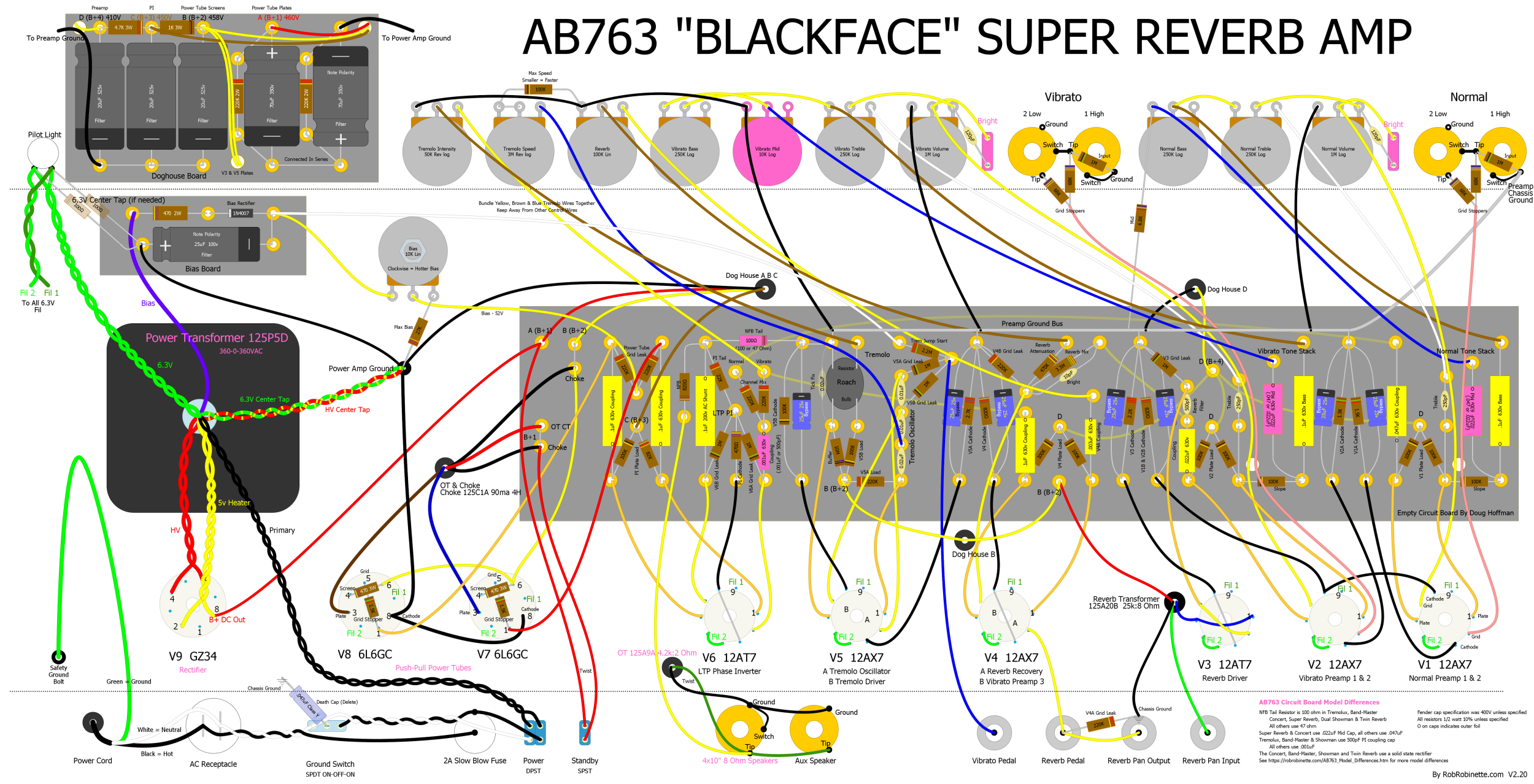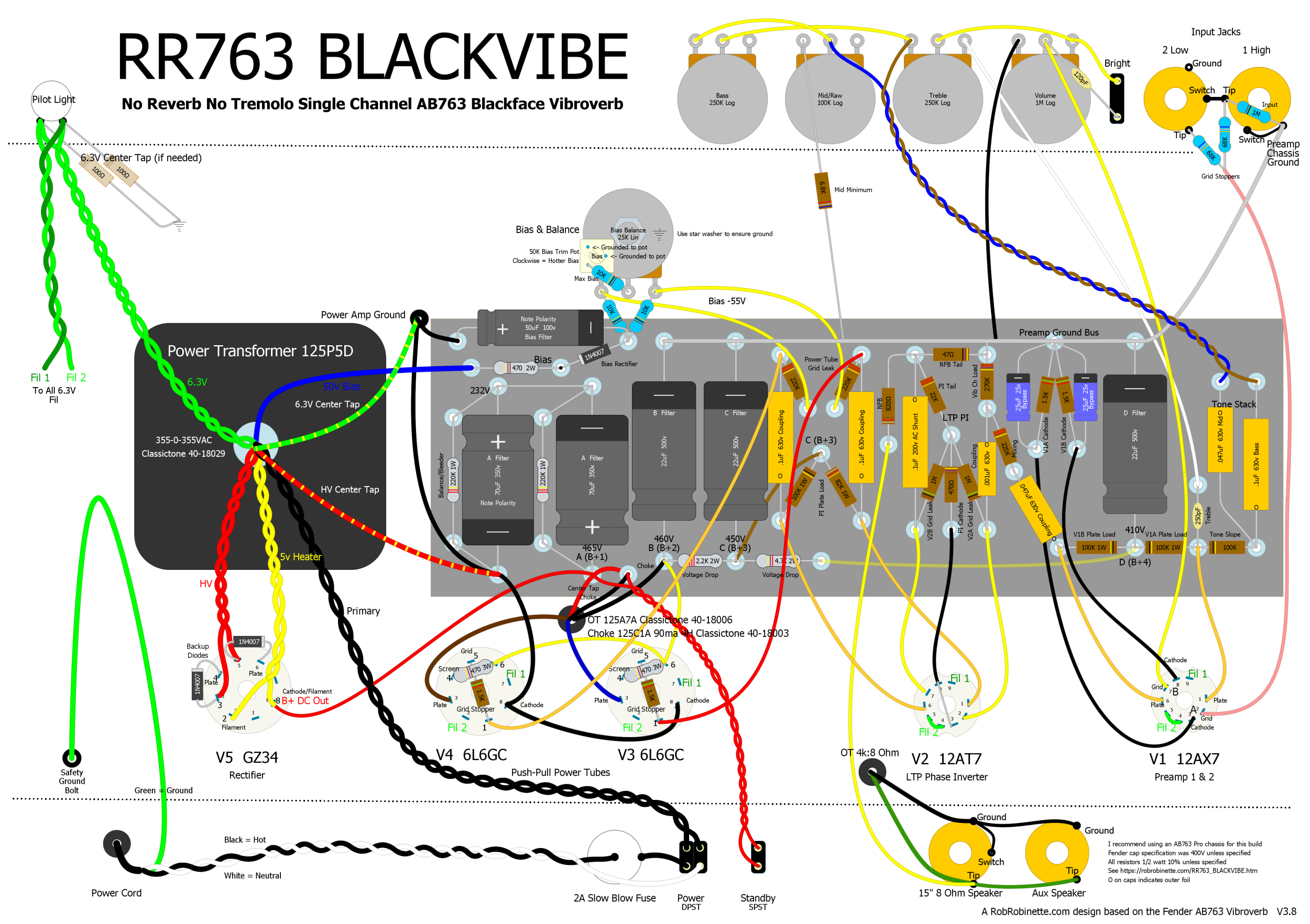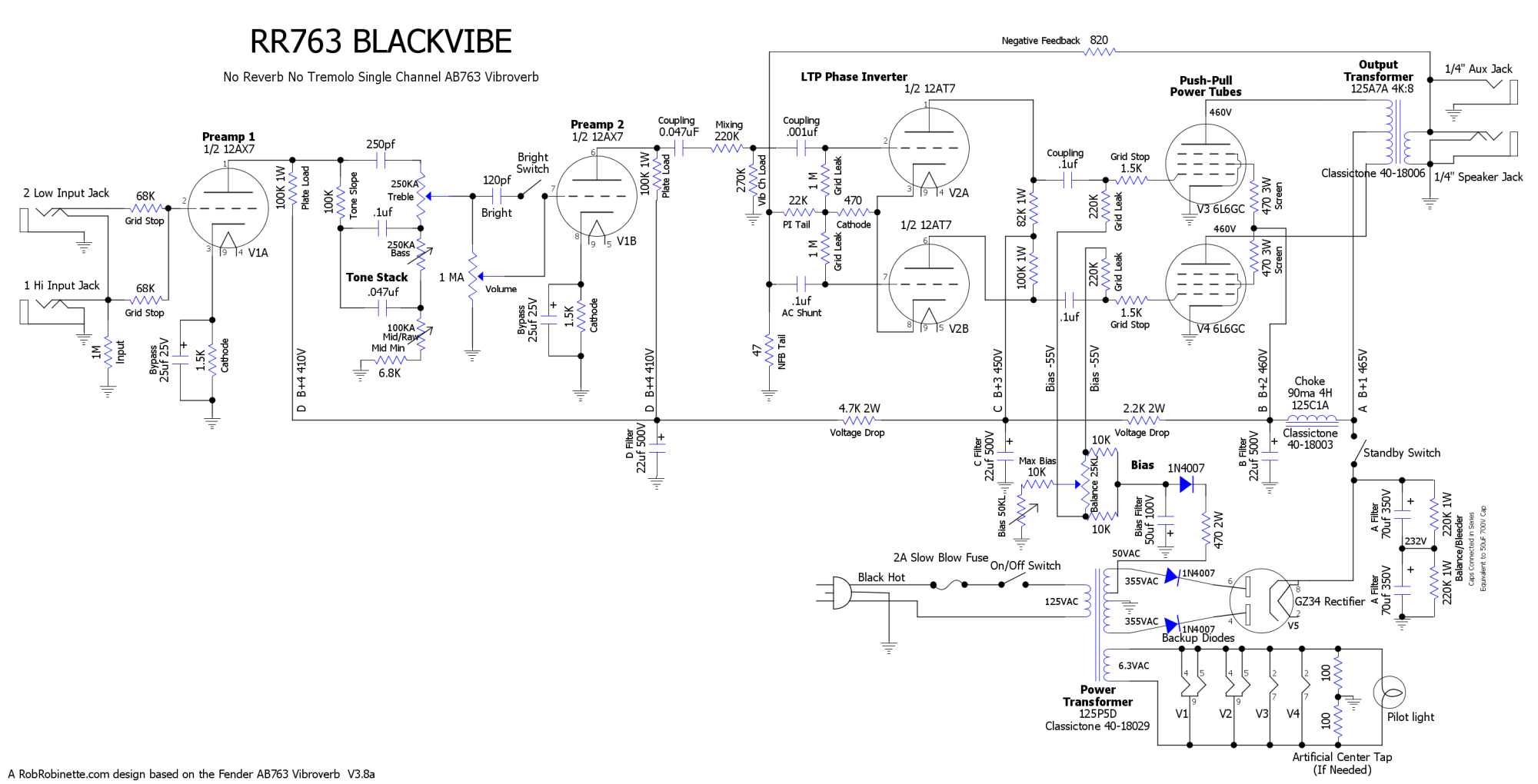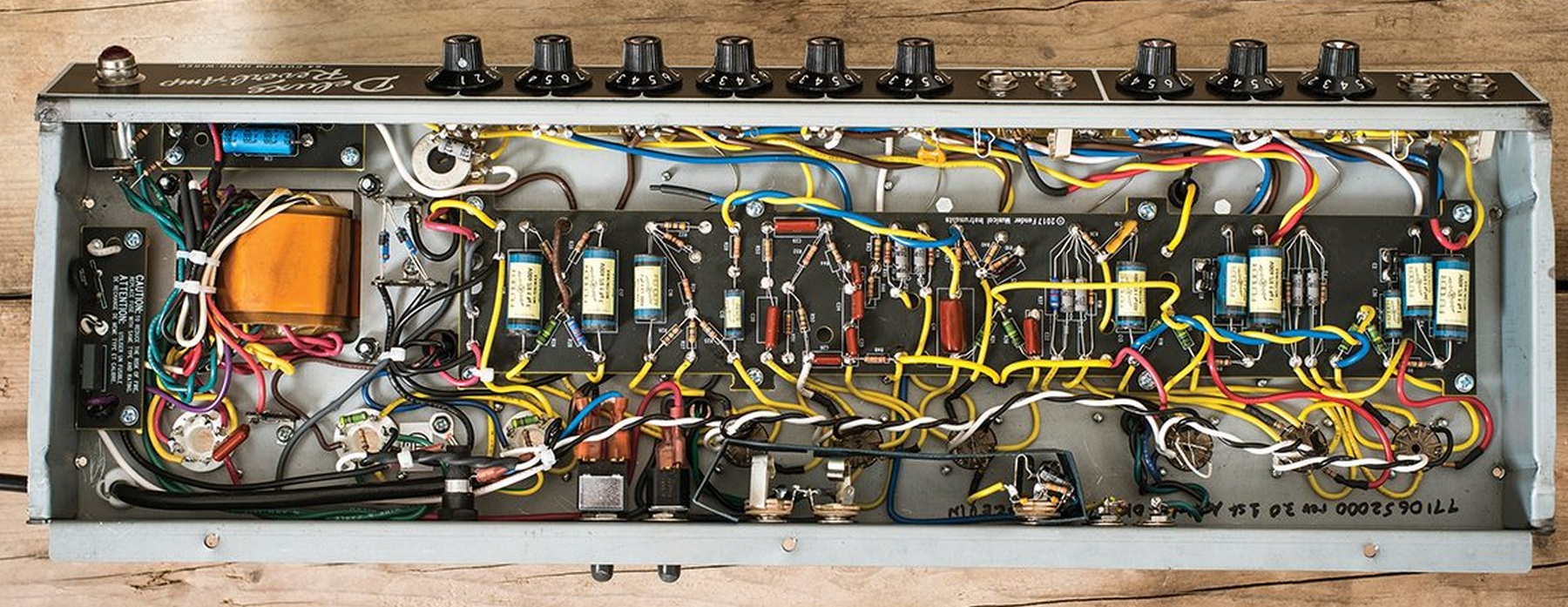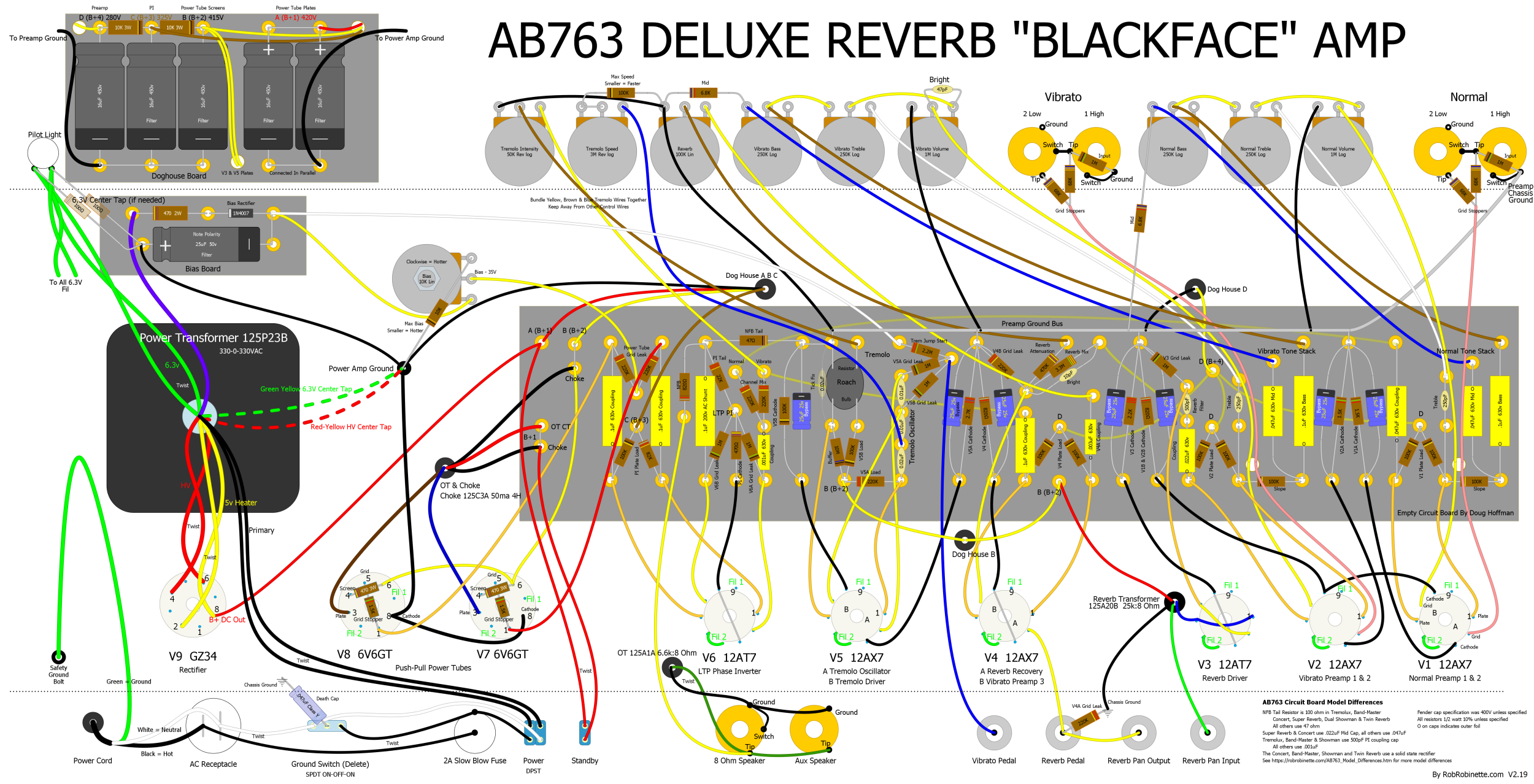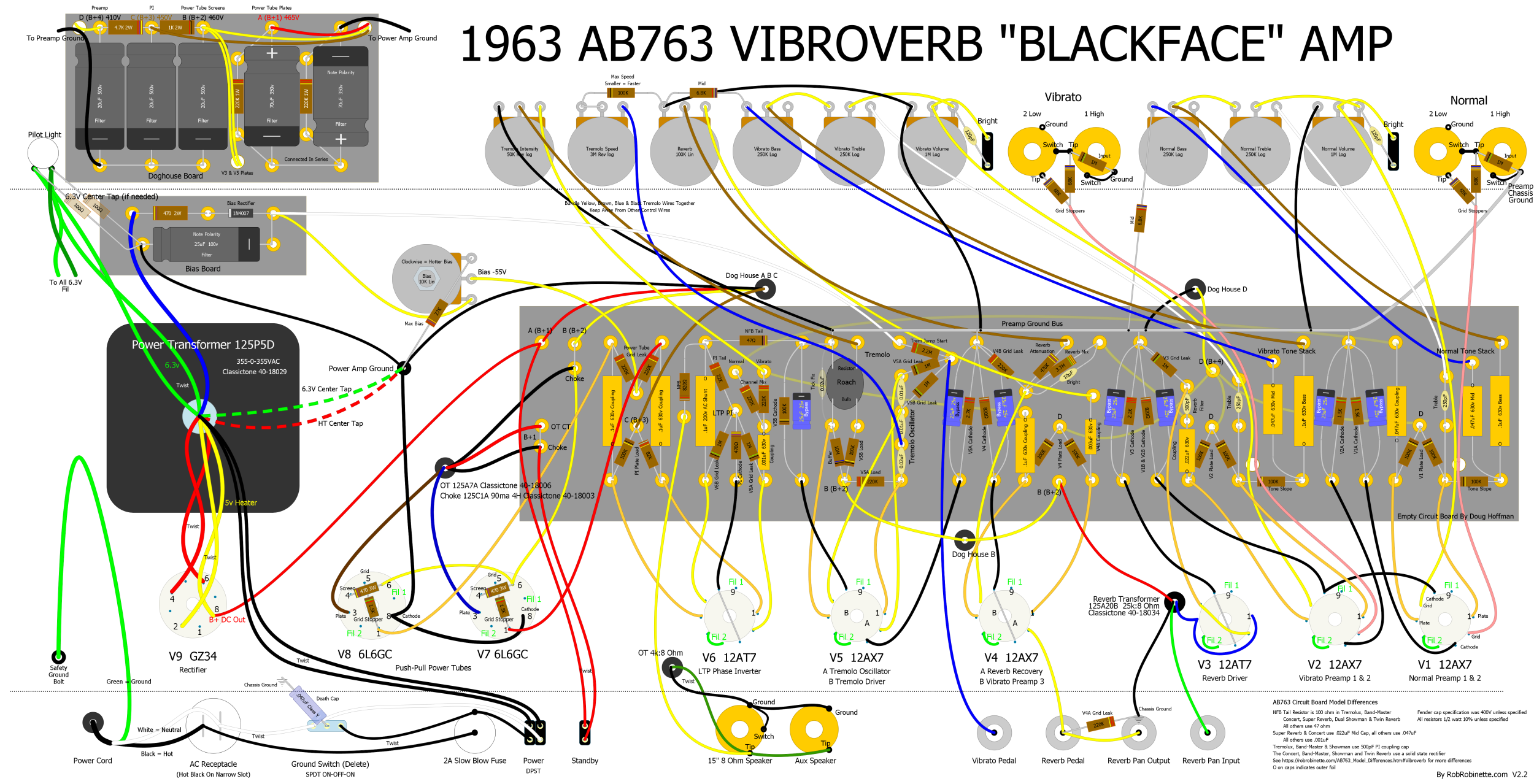Build an AB763 Blackface Amplifier
By Rob Robinette
The July '63 (763) Fender amplifier design is considered by most as the high water mark of Fender amplifier design.
Use this layout to guide your build. Model differences are highlighted in pink. Click on the layout to see the hi-res version. Download the pdf here. Download the DIYLC file here.
Fender Wire Routing
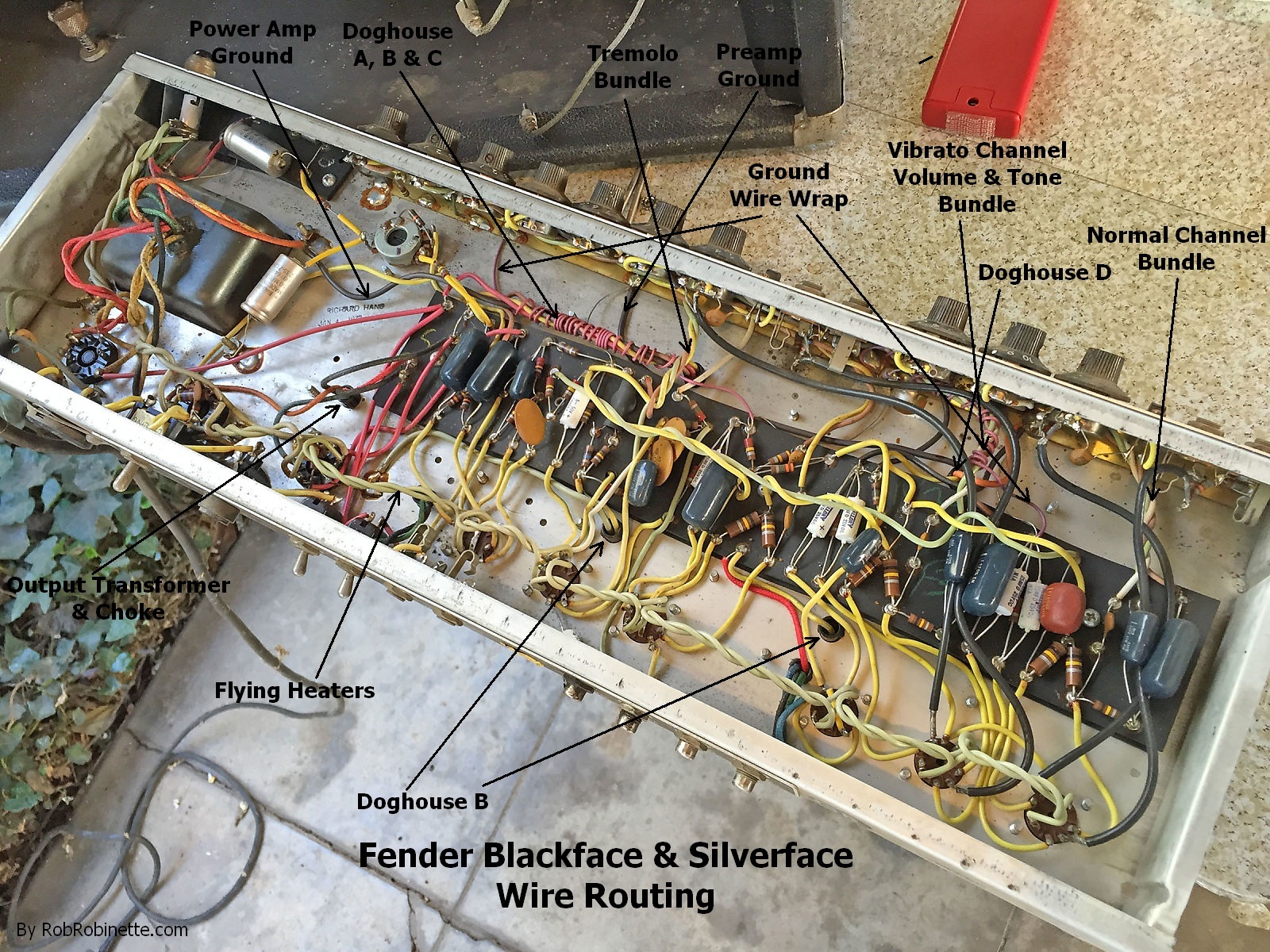
Note the two wire bundles that are wrapped with a reddish ground wire. The Vibrato channel volume and tone wires are wrapped and the Doghouse A, B & C power wires are wrapped. This was done as a "poor man's shield". Also notice how all the Tremolo wires are bundled and run along the chassis and then shoot straight down to their terminals. The tremolo wires carry a very strong signal that can bleed into other signal wires so pay close attention to their placement. This is my personal AA1069 silverface Bandmaster Reverb and it's a very quiet amp.
Which AB763 to Build?
Take a look at the AB763 Model Differences page to get a feel for which amp to build. My personal favorite is the Vibroverb because it has three preamp gain stages, reverb, high preamp voltage to drive the power tubes harder, a soft tube rectifier for more playing dynamics, a match-more-external-speakers 8 ohm output, smaller output transformer for more compression and sustain and the bold tone of a 15 inch speaker. It's also in high demand in the used and clone amp market.
You can make your build a lot simpler if you go with one of the non-reverb models such as the Deluxe, Vibrolux, Band-Master or Showman.
You also have the option of building a head cab from any of these models--how sexy would a Vibroverb head be? Keep in mind the reverb amps need a taller head cab to give enough separation between the reverb pan and power transformer.
AB763 Model Overview
| Preamp Stages | FX | Preamp Plate V | Pwr Tube Plate V | Power Tubes | Rectifier | Speakers | 1964 Price | 2019 Adjusted* | |
| Deluxe | 2 | Tremolo | 170 | 410 | 2 x 6V6 | GZ34 | 1x12, 8 ohm | $169.50 | $1,380 |
| Deluxe Reverb | 3 | Tremolo & Reverb | 180 | 410 | 2 x 6V6 | GZ34 | 1x12, 8 ohm | $239.50 | $1,949 |
| Vibrolux | 2 | Tremolo | 200 | 410 | 2 x 6L6 | GZ34 | 1x12, 8 ohm | $299.50 | $2,437 |
| Tremolux | 2 | Tremolo | 200 | 410 | 2 x 6L6 | GZ34 | Head Cab, 4 ohm | $329.50 | $2,681 |
| Pro | 2 | Tremolo | 275 | 460 | 2 x 6L6 | GZ34 | 1x15, 8 ohm | $299.50 | $2,437 |
| Band-Master | 2 | Tremolo | 275 | 440 | 2 x 6L6 | Solid State | Head Cab, 4 ohm | $309.50 | $2,517 |
| Concert | 2 | Tremolo | 270 | 440 | 2 x 6L6 | Solid State | 4x10, 2 ohm | $369.50 | $3,006 |
| Vibroverb | 3 | Tremolo & Reverb | 280 | 460 | 2 x 6L6 | GZ34 | 1x15, 8 ohm | $339.50 | $2,762 |
| Super Reverb | 3 | Tremolo & Reverb | 270 | 460 | 2 x 6L6 | GZ34 | 4x10, 2 ohm | $399.50 | $3,251 |
| Showman | 2 | Tremolo | 280 | 460 | 4 x 6L6 | Solid State | Head Cab, 8 ohm | $640.00 | $5,205 |
| Dual Showman | 2 | Tremolo | 280 | 460 | 4 x 6L6 | Solid State | Head Cab, 4 ohm | $915.00 | $7,439 |
| Twin Reverb | 3 | Tremolo & Reverb | 270 | 460 | 4 x 6L6 | Solid State | 2x12, 4 ohm | $479.50 | $3,901 |
| 65 DRRI | 3 | Tremolo & Reverb | 190 | 415 | 2 x 6V6 | *5AR4 | 1x12, 8 ohm | $1,099 | |
| 68 CDR | 3 | Tremolo & Reverb | 190 | 415 | 2 x 6V6 | *5AR4 | 1x12, 8 ohm | $1,049 |
Notes: Amps with reverb have 3 preamp gain stages in the Vibrato channel with slightly more gain and preamp distortion. The Super Reverb has a higher rated output transformer than the other 2 x 6L6 amps. *The 5AR4 rectifier is a GZ34 equivalent. *2019 inflation adjusted prices were calculated using the Bureau of Labor Statistics CPI Inflation Calculator.
Simple Blackface Amp Design
I designed the RR763 BLACKVIBE amp (see layout and schematic below) for builders who don't want to deal with the complexity of the AB763 circuit's reverb, tremolo and dual channels but still want its authentic tone.
Removing the reverb, tremolo and Vibrato Channel drops the preamp tube count to only two but the tone stays 100% Normal Channel Vibroverb. This amp uses authentic Vibroverb power and output transformers and choke so voltage levels and power output are all Vibroverb. The filter caps were moved from the doghouse to the circuit board for build simplicity.
Simple Blackface
No reverb, no tremolo, single channel AB763 Vibroverb. It's a very simple amp compared to the Vibroverb above. Download the BLACKVIBE pdf here and the DIYLC file here.
It's very much a single channel Vibroverb. Download the pdf here and the DIYLC file here.
See this for more info on the BLACKVIBE.
The circuit board differences between the different AB763 models are actually very limited. The Deluxe and Deluxe Reverb's doghouse cap value, power resistor and wiring differ from the rest of the AB763 amps. The NFB Tail resistor is 47 ohms for the single speaker amps and 100 ohms for the others. The phase inverter input coupling cap is .001uF in the combo cab amps and 500pF in the head amps. The tone stack mid cap is .022uF in the Super Reverb and Concert, and .047uF in all the other amps. Some silverface amps use a .033uF mid cap which is a nice compromise value. A smaller mid cap slightly reduces the mid scoop for an audible gain boost and also shifts the scoop a little higher in frequency.
The multi-speaker amps, the Tremolux, Band-Master, Concert, Super Reverb, Dual Showman and Twin Reverb use a "heavy" negative feedback (NFB) circuit compared to the other AB763 amps' "light" circuit. These multi-speaker amps used 2 and 4 ohm output transformer secondaries so the "heavy" NFB circuit compensated for the lower secondary voltages. The feedback circuit is made up of two NFB resistors that form a voltage divider. The "heavy" NFB circuit uses an 820 / 100 ohm divider while the others use a "light" 820 / 47 ohm circuit. The 820 / 100 "heavy" NFB circuit attenuates the output transformer secondary signal voltage by 89%. The 820 / 47 "light" NFB circuit cuts the signal by 95%. I'm a fan of lighter NFB so I typically use a 47 ohm NFB Tail resistor.
The head cab AB763's, the Tremolux, Band-Master and Showman, use 50% smaller 500pF coupling caps leading to the phase inverter compared to the other amps' 1000pF (.001uF). This was done to reduce bass frequencies into the Fender closed back extension cabs which exhibit extended bass response compared to open back combo cabs. The smaller cap also tends to tighten up the overdrive tone.
Some models have Mid tone controls in one or both channels and Bright switches. In models without Bright switches a Bright cap is placed on the Vibrato channel Volume pot.
Some models use a solid state rectifier versus a tube rectifier. The power and output transformers also differ between the AB763 models.
Mojotone.com sells high quality AB763 kits and Doug Hoffman sells empty eyelet or turret circuit boards.
I recommend Classictone transformers.
For the Deluxe and Deluxe Reverb use their 40-18002 6.6k:8ohm or the 40-18038 if you want a 4 & 8 ohm output output transformer (4 ohm is perfect for two 8 ohm speakers). For USA amps use their 40-18016 power transformer. For outside the USA use the 40-18017 (120 & 240v) or 40-18028 (100/120/220/230/240v).
For 2x6L6 amps the 40-18105 output transformer supports 2/4/8 ohm output. 2 ohm is for four 8 ohm speakers like the Concert, 4 ohm is for two 8 ohm speakers in the Bandmaster & Tremolux. The Super Reverb uses the 40-18000 4.2k:2/4/8 ohm output transformer. For power transformers the Vibrolux and Tremolux use the 40-18041 or 40-18096 for outside the USA. The Bandmaster & Concert use the 40-18005 or the 40-18097 for outside the USA. For all other 2x6L6 amps use the 40-18029 power transformer which supports 100, 120, 220 & 240v mains voltage.
For 4x6L6 amps use the 40-18012 2k:4ohm, 40-18113 2k:4/8ohm or 40-18102 2k:4/8/16ohm output transformers depending on what outputs you want. 4 ohm is for two 8 ohm speakers connected in parallel like the Twin Reverb & Dual Showman, 8 ohms is for one 8 ohm speaker like in the Single Showman and 16 ohms is for two 8 ohm speakers connected in series.
Deviations From the Original 1963 Layout
You must use a 3-prong power cord. The power cord safety ground wire should be bolted to the chassis using a dedicated bolt with some type of lock nut to keep it secure. Leave extra length of this wire so if the power cord is accidentally pulled out of the chassis it should be the last wire to disconnect.
For safety reasons you should delete the ground switch. To delete the switch you can just remove the death cap (located under the switch) or disconnect the hot and neutral wires. If you are dead set on keeping the Ground Switch and "death cap" then you must replace the cap with a Class Y safety capacitor that is designed to run from the mains to ground. This $1 Kemet 900 Series .01uF 400VDC 250VAC Class Y safety capacitor is what you want for mains voltage up to 250 volts AC. The Ground Switch itself is a 3-way ON-OFF-ON SPDT. If you do keep the Ground Switch then power it from the fuse out terminal. This will add fuse protection for a death cap short. A repurposed Ground Switch can be used to switch things such as NFB resistance or a 1/2 power switch.
I recommend using a double post single throw (DPST) switch for the power switch as shown in the layout above so you can switch both the hot and neutral mains lines. This Carling DPST is perfect for this. This switching method meets the current required worldwide safety standard for power switches.
Fender used a complicated split power/preamp ground scheme with many ground connections from the circuit board to a brass plate mounted between the chassis and control panel. I recommend the split ground bus scheme shown in the above layout.
Recommended Upgrades
The power cord hot (black) wire should run to the AC Receptacle first, then to the Fuse center terminal. You don't want to power the AC Receptacle with fused power because you could blow the amp's main fuse when plugging in something that uses more than two amps of power. Some people chose to leave the AC Receptacle disconnected. You can replace the USA 2-prong receptacle with a 3-prong 160-2-N receptacle to allow the use of modern accessories with a 3-prong power cord. See the above layout diagram for power cord wiring details.
3-Prong 160-2-N Receptacle
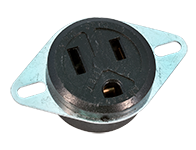
This is an easy bolt-in replacement available here.
The layout above has higher watt rated resistors for the power tube screens and doghouse voltage dropping resistors (they were all 1 watt originally). This has no effect on tone but will help with longevity.
I also highly recommend using 2 watt resistors for all plate resistors. I took a thermal image of a 5F6A Bassman chassis and all the 100k 1/2 watt plate resistors glowed very hot. Again this will have no effect on tone but will reduce resistor hiss noise and extend longevity.
Consider using metal film resistors throughout the amp except for the doghouse and power tube screen resistors. Metal film resistors generate 1/10th the resistor hiss of traditional carbon composition resistors. You can keep the amp quiet but add some mojo by using carbon comp resistors just for the phase inverter plates and tail resistors.
Upgrade the first two filter caps in the doghouse from 70uF 350 volt to 100uF 350v (or higher volt rating). This will reduce hum and slightly tighten up the bottom end.
Upgrade the bias filter cap from 25uF to 100uF 100v. This will not affect the amp's tone but it may decrease hum and increase longevity.
The AB763 Concert, Pro, Vibrolux and Vibroverb use the 125A7A 4k:8 ohm transformer. I recommend this transformer for most AB763 builds with one speaker.
In many silverface amps Fender used shielded cable for the runs from the input jacks to the tubes and from the volume pots to the tubes to reduce noise and hum. RG174 is my preferred cable for amp use.
Mount the power and output transformers to the chassis first. Do not twist the output transformer wires, especially the primary wires that run to the power tube sockets. Twisting them together can allow capacitive coupling and the loss of high frequencies.
Consider this list of my favorite AB763 mods:
robrob Normal Channel Reverb Mod to add reverb to the normal channel. This mod also puts the two channels in phase so you can jumper them for a thicker tone.
Tremolo Cut Switch Mod Add a lot of preamp gain with this simple and very useful mod.
Slow the Tremolo Slow is good.
Reduce Reverb Noise & Oscillation Simple mod to clean up the reverb.
Browse through other AB763 mods.
For more info on actually building an amp see How to Build a Tube Amp.
Fender Modern Hand Wired 68 Custom Deluxe Reverb
This is how Fender does a modern hand wired AB763 amp. Note the use of quiet metal film resistors except the V3 2.2k cathode resistor. The small board at far left adds a soft start thermistor and Class X RFI noise cap to the mains line. Artificial 6.3v heater center tap resistors are connected to the pilot light at far upper left. The Power switch switches both the mains hot and neutral lines. The Ground Switch and AC Receptacle have been deleted.
Very Clean Original AB763
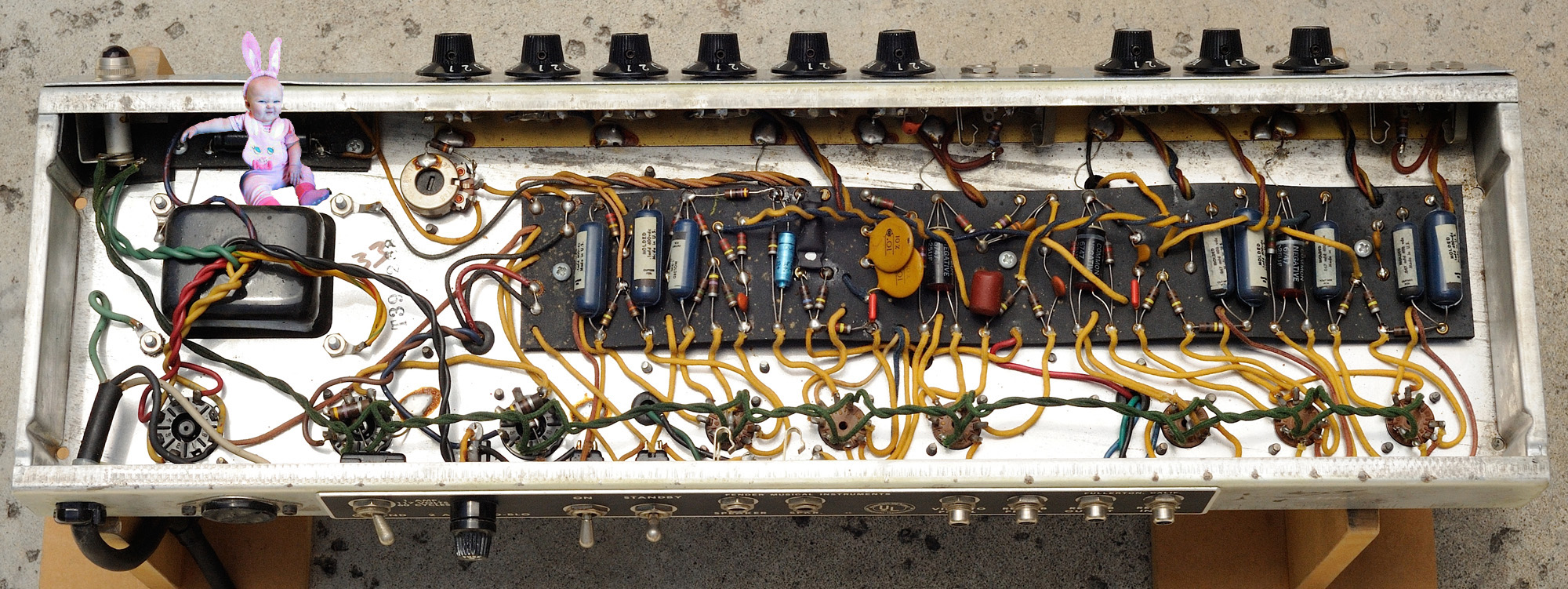
Note the brass grounding plate at top with multiple bare ground wires running between it and the circuit board, bundled and twisted wires running from the control panel and doghouse and the multitude of chassis grounds. There are also chassis grounds on the rear panel Ground Switch and on the Reverb Out jack.
Just a Few of the Chassis Grounds
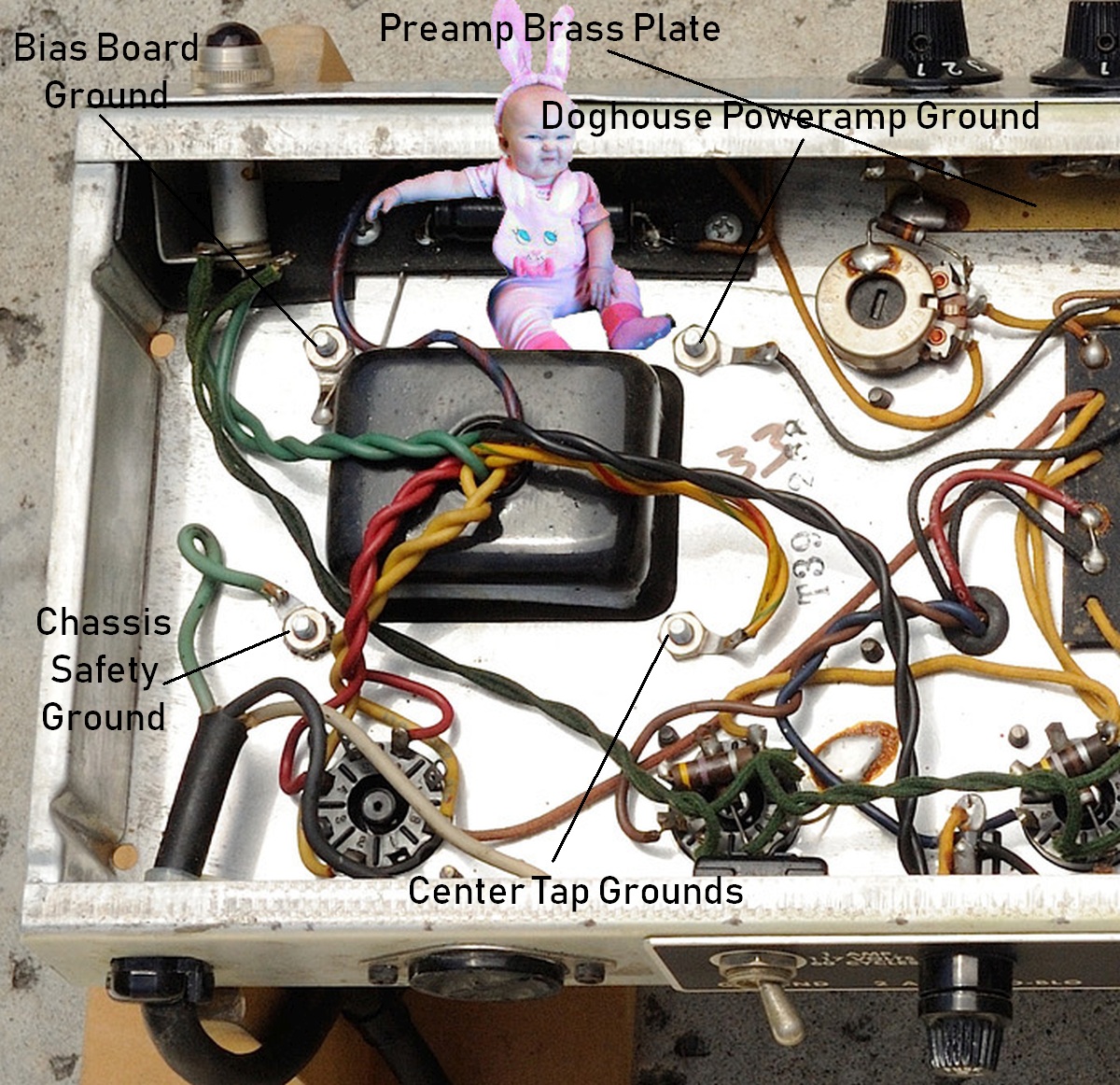
Non-Reverb AB763
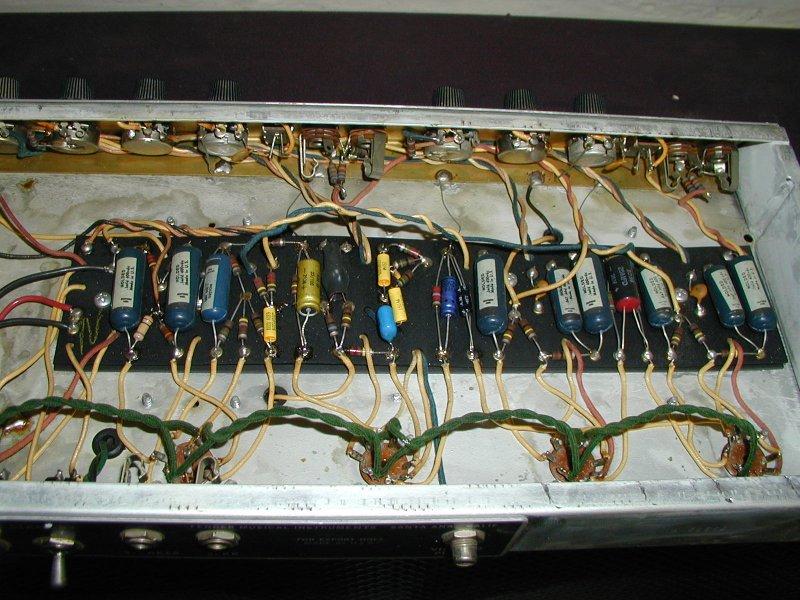
Original Fender Super Reverb Schematic
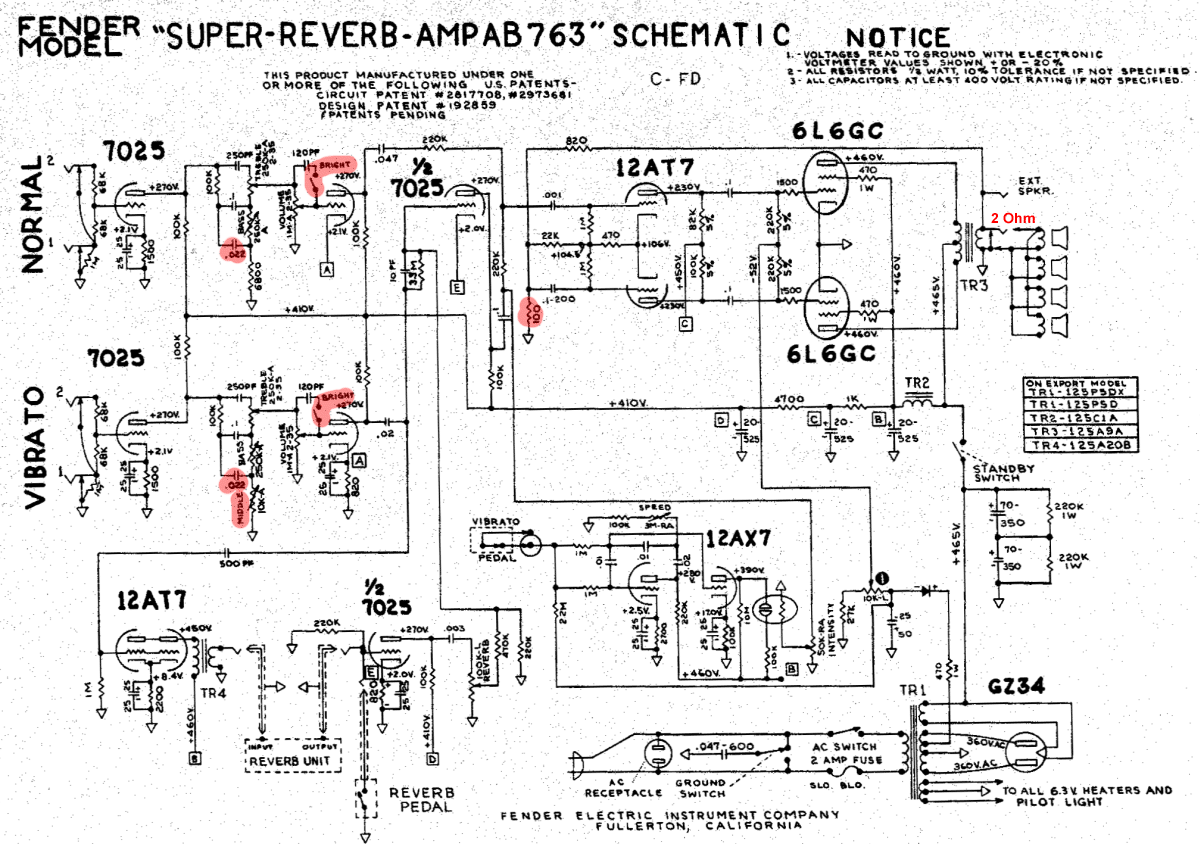
The Super Reverb and Concert are the only AB763s with .022uF middle tone caps. Note the Middle tone control on the Vibrato Channel (highlighted center-left).
Original Fender Super Reverb Layout
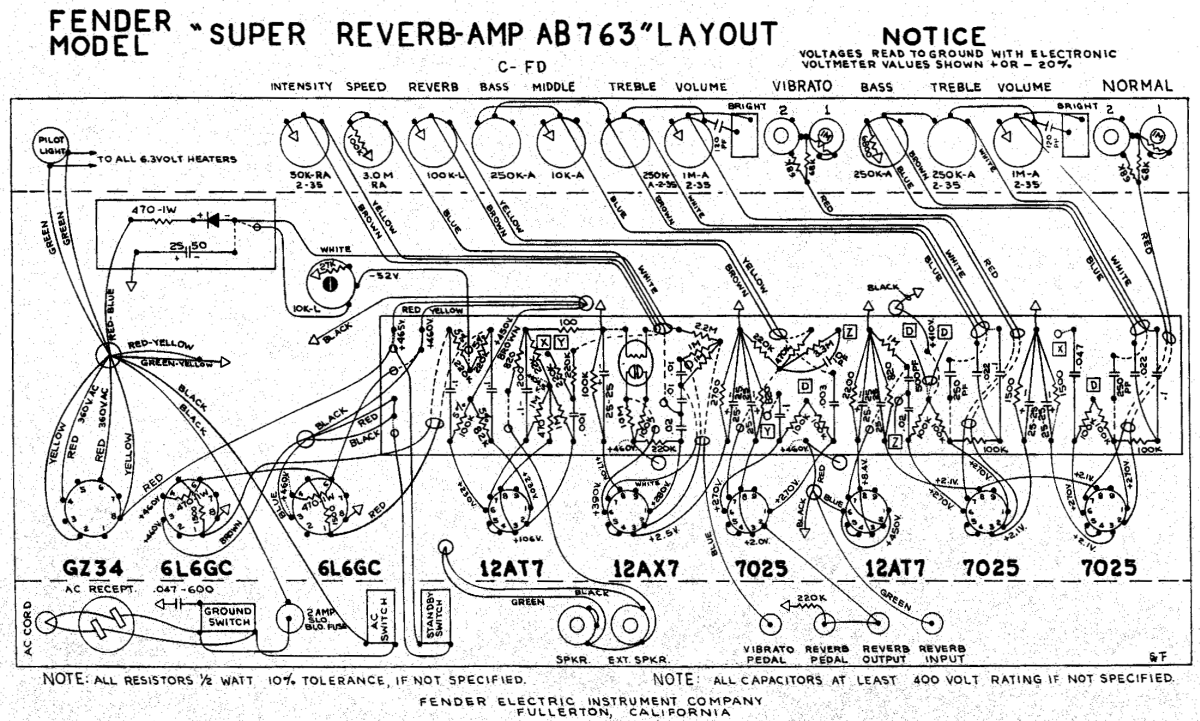
Annotated AB763 Schematic With Component Function
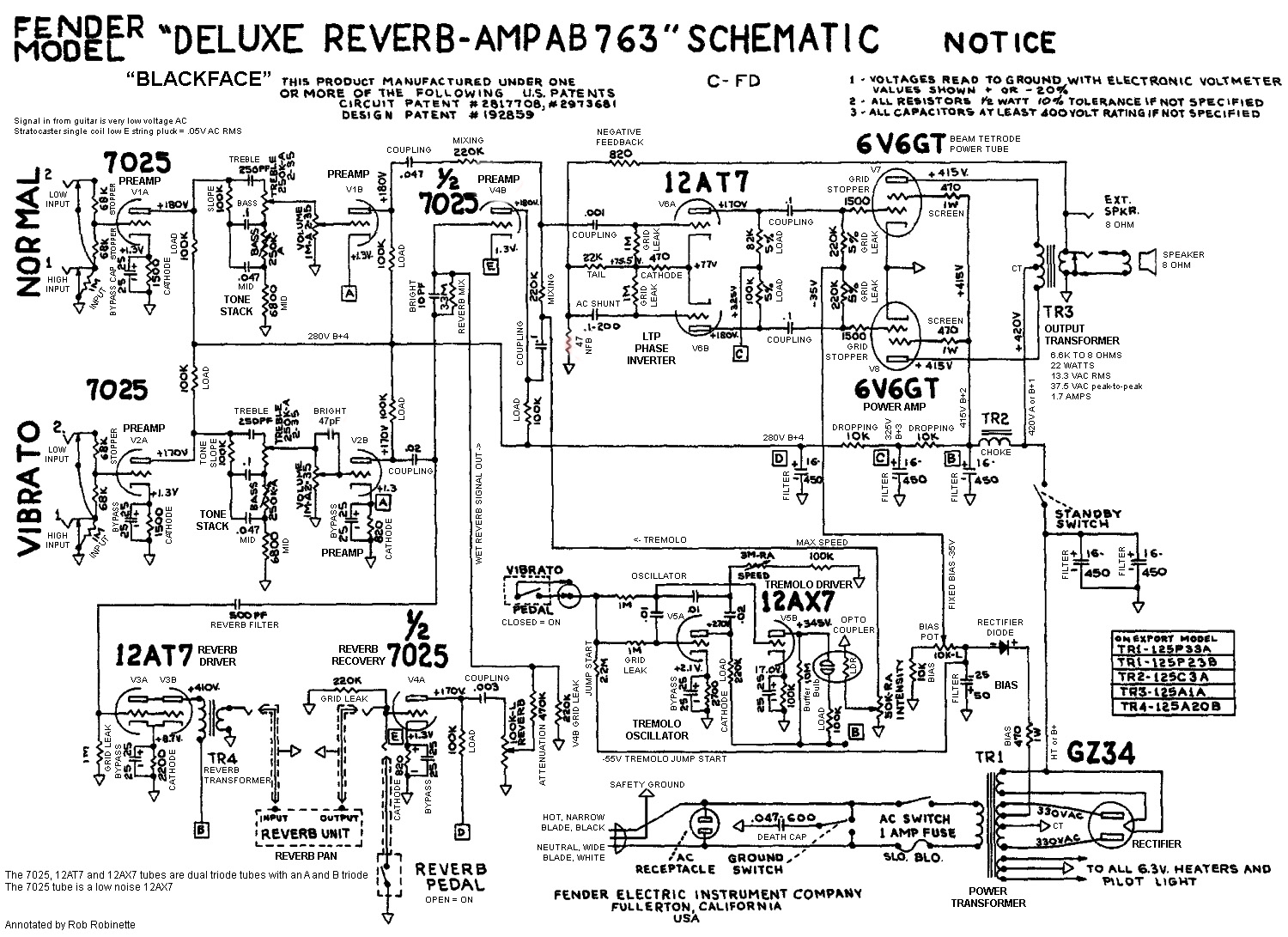
Deluxe Reverb Layout
Note the differences in the doghouse board at upper left. The first two filter caps (B+1) in the Deluxe Reverb are wired in parallel. The Deluxe has only one 16uF B+1 cap. All the other AB763 amps connect the first two filter caps (B+1) in series. The Voltage Dropping resistors are also different. Click the image for the hi-res layout. Download the pdf here and download the DIYLC file here.
Vibroverb Layout
Click on the layout to see the hi-res version. Download the pdf here. Download the DIYLC file here.
By Rob Robinette
References
RCA Corporation, RCA Receiving Tube Manual, RC30.
Merlin Blencowe, Designing Tube Preamps for Guitar and Bass, 2nd Edition. This is my personal favorite tube amp book.
Merlin Blencowe, Designing High-Fidelity Tube Preamps
Morgan Jones, Valve Amplifiers, 4th Edition.
Richard Kuehnel, Circuit Analysis of a Legendary Tube Amplifier: The Fender Bassman 5F6-A, 3rd Edition.
Richard Kuehnel, Vacuum Tube Circuit Design: Guitar Amplifier Preamps, 2nd Edition.
Richard Kuehnel, Vacuum Tube Circuit Design: Guitar Amplifier Power Amps
Robert C. Megantz, Design and Construction of Tube Guitar Amplifiers
Neumann & Irving, Guitar Amplifier Overdrive, A Visual Tour It's fairly technical but it's the only book written specifically about guitar amplifier overdrive. It includes many graphs to help make the material easier to understand.
T.E. Rutt, Vacuum Tube Triode Nonlinearity as Part of The Electric Guitar Sound
